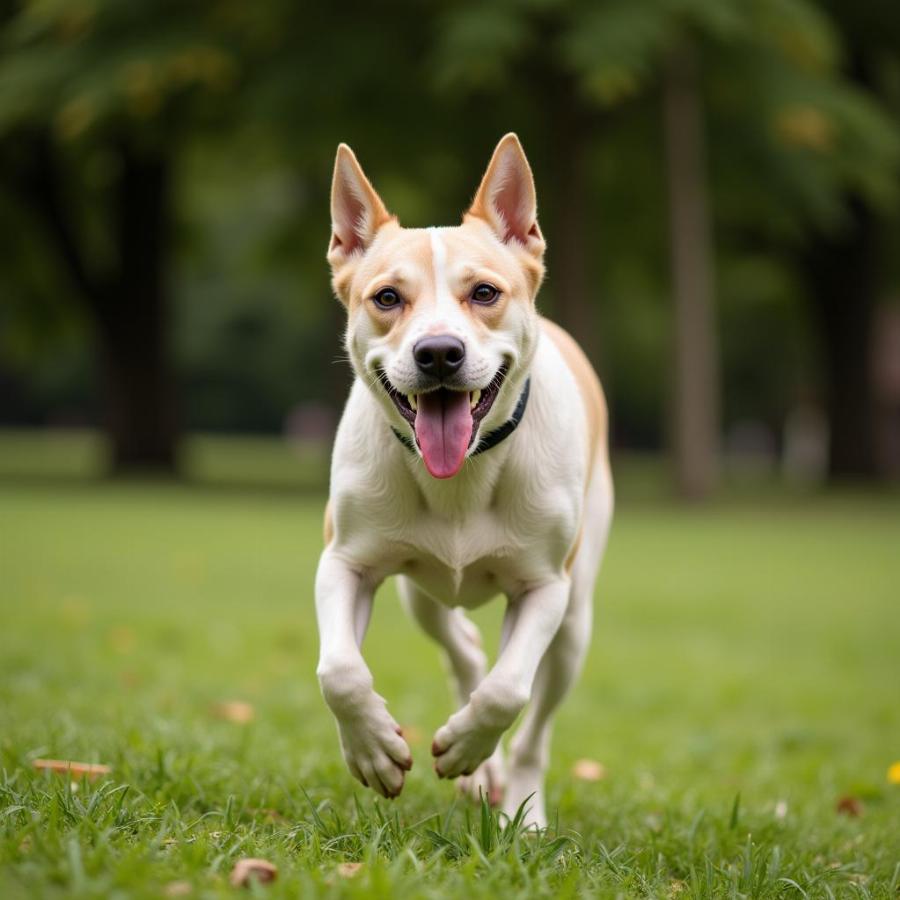A “dog at large” essentially refers to a dog that is not under the control of its owner and is roaming freely in public, outside of its owner’s property and not on a leash. This can present various risks, not only to the dog itself but also to the community. Understanding what constitutes a “dog at large,” the potential consequences, and preventative measures is crucial for responsible dog ownership.  Chó thoát khỏi sự kiểm soát của chủ
Chó thoát khỏi sự kiểm soát của chủ
Why is the Issue of “Dogs at Large” Important?
The issue of dogs at large isn’t just about following local ordinances. It’s about safety and responsibility. A dog off-leash, even a friendly one, can become startled or agitated, leading to unpredictable behavior. This poses a threat to other animals, people, and even the dog itself. From traffic accidents to potential bites, the consequences can be severe. Understanding the implications of a dog at large is the first step toward preventing it.
Legal Implications of a “Dog at Large”
Most jurisdictions have specific laws and regulations concerning dogs at large. These ordinances often include fines, mandatory leash laws, and potential legal action if your dog causes harm or damage while roaming freely. In some cases, repeated offenses can even lead to the impoundment or euthanasia of the dog. Familiarizing yourself with your local laws is paramount.
Understanding Your Local Leash Laws
Leash laws vary depending on your location. Some areas may have designated off-leash dog parks, while others require dogs to be leashed at all times in public spaces. Check your local government’s website or contact your animal control office for specific information regarding leash laws in your area.
Protecting Your Dog and Your Community: Preventing “Dog at Large” Situations
Preventing a dog at large situation is not only legally required but is also a crucial aspect of responsible pet ownership. By taking proactive steps, you protect your dog, your community, and avoid potential legal and financial repercussions.
Secure Fencing and Gates
Ensure your property has secure fencing that is high enough and sturdy enough to prevent your dog from escaping. Regularly inspect fences for any weaknesses or holes. Gates should be self-closing and latch securely. Consider installing double gates for added security.
Proper Identification
Microchipping is a permanent form of identification that significantly increases the chances of your dog being returned if it gets lost. Ensure your dog wears a collar with updated identification tags, including your name, address, and phone number.
Effective Leash Training
Training your dog to walk calmly and obediently on a leash is vital. A well-trained dog is less likely to pull or lunge, reducing the risk of breaking free from its leash.
Obedience Training
Basic obedience commands, such as “come,” “stay,” and “leave it,” are crucial for controlling your dog in various situations and can help prevent them from running off.
What to Do if Your Dog Gets Loose
Despite your best efforts, dogs can sometimes get loose. If your dog becomes a dog at large, remain calm and act quickly.
- Call your local animal control or shelter: Report your dog missing immediately.
- Search your neighborhood: Call your dog’s name and look in places they frequently visit.
- Leverage social media: Post pictures and information about your lost dog on local community groups.
- Contact your microchip registry: If your dog is microchipped, notify the registry that your dog is missing.
Conclusion
Understanding the meaning and implications of “dog at large” is essential for responsible dog ownership. By taking proactive steps, such as securing your property, providing proper identification, and investing in obedience training, you can significantly reduce the risk of your dog getting loose. Remember, keeping your dog safe and preventing it from becoming a dog at large is not only a legal obligation but also a crucial part of being a responsible pet owner.
FAQ
- What is the legal definition of a dog at large? It generally refers to a dog off its owner’s property and not under their immediate control, usually off-leash.
- What are the penalties for having a dog at large? Penalties vary by location but often include fines and potential legal action.
- What should I do if I find a dog at large? Contact your local animal control or animal shelter.
- Is it ever okay to let my dog off-leash? Only in designated off-leash areas, if permitted by local ordinances.
- How can I prevent my dog from becoming a dog at large? Secure fencing, proper identification, and obedience training are key.
- What if my dog gets loose and bites someone? You could be held liable for any injuries or damages.
- Where can I find information on leash laws in my area? Check your local government’s website or contact your animal control office.
Beaut Dogs is your trusted resource for comprehensive information on all aspects of dog ownership, from breed selection to care guides. We’re passionate about helping you provide the best possible life for your canine companion. For personalized advice and support, contact us at Email: [email protected]. Beaut Dogs is committed to providing accurate and reliable information to empower dog owners.